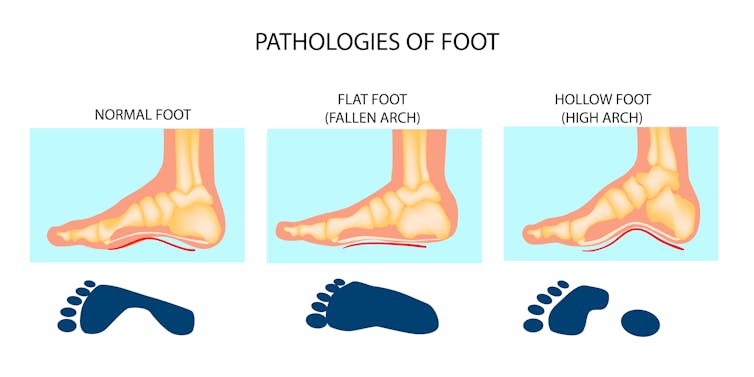Humans have gone unshod for millions of years; it is only in the last few centuries that people have started wearing shoes. However, a recent survey shows that shoe wearing among young boys isn’t universal. German children and teenagers spend most of their day in shoes, while about 90% of their South African counterparts go barefoot.
Aside from the obvious climate differences, it is tempting to think that South Africa’s lower economic ranking, compared with Germany’s, is the main reason for the absence of footwear. But this reasoning has been challenged by results from our recent survey.
We gathered information on the footwear habits of 714 boys attending a secondary school in a wealthy part of Auckland, New Zealand. Almost half of the students (45%) spent most of their time barefoot. Many of the students in this study were even willing to run distances of 100 to 3,000 metres on a hard track surface without shoes.
Foot structure with shoes and barefoot
Differences in foot structure between those who have never worn shoes and those who are usually in shoes have been described for over a century. In one seminal 1905 study, Phil Hoffman, warned how putting the fashionable desires of customers over the health of their feet had led to shoe design “that more or less crowds the front of the foot”.
The main developmental result of growing up in shoes appears to be a narrower foot and a lower arch. The result of this is more concentrated pressure at the heel and the ball of the foot during movement.
By contrast, those who grow up barefoot have wider feet and have a more even distribution of pressure towards the outside edge of the foot and across the toes.

Sakurra/Shutterstock.com
Running as nature intended: barefoot
We don’t know what effect growing up in shoes has on the development of movement skills, or the risk of injury in sport, but logic suggests that growing up barefoot is a good thing.
The heel of the foot is highly sensitive to pain, meaning that when people run barefoot they tend to avoid landing on their heel and instead defer the pressure to the mid and forefoot. This allows a broader surface area to absorb force.
In order to avoid a heel strike, the foot must never be too far in front of the body. As a result, barefoot runners tend to have a shorter stride. A shorter stride needs less leg extension, which is why barefoot runners have greater bend at the knee and a more pointed foot toward the floor. These joint positions allow muscles around the knee to help control landing and allow the ankle to behave in a more spring-like fashion.
The problem with shoes
Covering the heel of the foot reduces the sensation it experiences when coming into contact with the ground. The running shoe, containing a cushioned heel, allows the runner to land on the heel of the foot with an extended leg. This is perhaps why about 75% of runners nowadays are heel strikers.
Running using an extended limb (overstriding) results in force being absorbed through the heel, bony structures and joints, with less assistance from muscle. This may be one of the reasons most running injuries are to structures that are not designed to absorb force (shins, feet and knees). Interestingly, when people remove their shoes, most revert to middle and forefoot striking.
Children and teenagers who grow up mostly barefoot appear strong enough to run quickly and for long distances without shoes. The prevalence of leg pain in the New Zealand students we studied was at the lower end of that reported globally in students of a similar age. This finding, combined with an absence of evidence for the role of shoes in the prevention of injury, makes it seem reasonable to suggest that children should spend as much time as possible barefoot.
Social acceptability is a barrier to barefoot activities in many Western countries, as a result, adults who did not grow up mostly barefoot may not have the same foot structure and leg strength to transition to barefoot activities quickly.
Gradually building time spent walking and running in bare feet is key for people who are new to barefoot activities. The increasing availability of shoes that mimic the structure of the foot (minimalist shoes) and have little cushioning other than to cover the foot, may help people transition to being barefoot. The improving design of these shoes may also help to tackle the issue of social acceptability.
Peter Francis, Director of the Musculoskeletal Science Research Group, Leeds Beckett University
This article was originally published on The Conversation. Read the original article.

